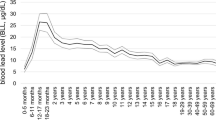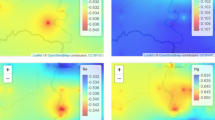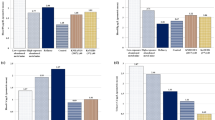Abstract
The South-eastern Area (SA) of the Municipality of La Spezia (Liguria Region, Italy) is characterised by a heavy environmental lead (Pb) contamination, chiefly due to the emissions of a Pb-processing plant in operation since 1930. In order to assess the risk of Pb poisoning of residents of SA, and to estimate the degree of association between the blood Pb level (BLL) and haematocrit % (HCT), intended as a biomarker of early haematological dysfunction, we reanalysed data of 785 individuals collected in 1992 as a part of a larger national biological monitoring project. Multiple normal regression modelling was applied to estimate the role of residence on log-transformed BLL, and Median Ratio (MR) was used as an index of effect. The same statistical modelling was also applied to reveal the relationship between HCT and BLL. Allowing for several confounders (including occupational exposure to Pb), residents of SA showed a 14% increase (MR=1.14, 95% IC=1.06–1.23%) in the median BLL value compared to people living outside SA. The excess reached 27% (MR=1.27, 95% IC=1.14–1.41%) after 30 years of residence. Parallel results were also obtained in a subgroup composed only of pupils (<18 years, non-smokers, non-drinkers). Finally, regression analysis highlighted a statistically significant parabolic trend in HCT in relation to BLL. The non-linear dose–response relationship, which attests to an adverse effect on the erythrocytic function of BLLs at least over 17.00 μg/dl, is in agreement with the findings of other authors and consistent with the results of an excess occurrence of self-reported anaemia obtained from a previous comparative survey carried out on the same population.
This is a preview of subscription content, access via your institution
Access options
Subscribe to this journal
Receive 6 print issues and online access
$259.00 per year
only $43.17 per issue
Buy this article
- Purchase on Springer Link
- Instant access to full article PDF
Prices may be subject to local taxes which are calculated during checkout


Similar content being viewed by others
References
Apostoli P., Bellini A., Porru S., and Bisanti L. The effect of lead on male fertility: a time to pregnancy (TTP) study. Am J Ind Med 2000: 38: 310–315.
Cleveland W.S. Robust locally weighted regression and smoothing scatterplots. J Am Statist Assoc 1979: 74: 829–836.
Fontana V., Baldi R., Franchini M., Gridelli P., Ceppi M., Magnoni U., and Puntoni R. Epidemiologic study of the residents of the southeastern area of the Municipality of La Spezia. Epidemiol Prev 2000: 24: 172–179.
Fu H., and Boffetta P. Cancer, occupational exposure to inorganic lead compound: a meta-analysis of published data. Occup Environ Med 1995: 52: 73–81.
Furman A., and Laleli M. Maternal. umbelical cord blood lead levels: an Istanbul Study. Arch Environ Health 2001: 56: 26–28.
Gottlieb S. Sustained fall in UK blood lead level. BMJ 1998: 317: 99.
Hense H.W., Filipiak B., Novak L., and Stoeppler M. Nonoccupational determinants of blood lead concentrations in a general population. Int J Epidemiol 1992: 21: 753–762.
Hertz-Picciotto I. The evidence that lead increases the risk for spontaneous abortion. Am J Ind Med 2000: 38: 300–309.
Hillman R.S. Anemia. In: Fauci A.S. (ed). Harrison's Principles of Internal Medicine. McGraw Hill, New York, 1998, pp. 334–339.
Jacob B., Ritz B., Heinrich J., Hoelscher B., and Wichmann H.E. The effect of low-level blood lead on hematologic parameters in children. Environ Res 2000: 82: 150–159.
Kleinbaum D.G., Kupper L.L., Muller K.E., and Nizam A. Applied Regression Analysis and Other Multivariable Methods. 3rd edn. PWS- Kent Publishing Company, Boston, 1998.
Lorente C., Cordier S., Bergeret A., De Walle H.E., Goujard J., Ayme S., Knill-Jones R., Calzolari E., and Bianchi F. Maternal occupational risk factors for oral clefts. Occupational Exposure and Congenital Malformation Working Group. Scand J Work Environ Health 2000: 46: 137–145.
Mahaffey K.R., McKinney J., and Reigart J.R. Lead and compounds. In: Lippmann M. (Ed.). Environmental Toxicants. Human Exposures and Their Health Effects. Van Nostrand Reinhold, New York, 1992, pp. 360–391.
Markowitz M. Lead poisoning: a disease for the next millennium. Curr Probl Pediatr 2000: 30: 62–70.
Miettinen O.S. Theoretical Epidemiology: Principles of Occurrence Research in Medicine. John Wiley & Sons, New York, 1985, pp. 237–238.
Neri R., and Palmieri F. Blood lead levels in the population of La Spezia. Ann Ist Super Sanità 1998: 34: 51–57.
Ojajarvi I.A., Partanen T.J., Ahlbom A., Boffetta P., Hakulinen T., Jourenkova N., Kauppinen T.P., Kogevinas M., Porta M., Vainio H.U., Weiderpass E., and Wesseling C.H. Occupational exposures and pancreatic cancer: a meta-analysis. Occup Environ Med 2000: 57: 316–324.
Perkins L.S. Normal blood and bone marrow values in humans. In: Lee G. (Ed.). Wintrobe's Clinical Hematology. 10th edn. Lippincott Williams & Wilkins, Baltimore, 1999, pp. 2738–2750.
Pesch B., Haerting J., Ranft U., Klimpel A., Oelschlagel B., and Schill W. Occupational risk factors for renal cell carcinoma: agent-specific results from a case–control study in Germany. MURC Study Group. Int J Epidemiol 2000: 29: 1014–1024.
Restrepo H.G., Sicard D., and Torres M.M. DNA damage and repair in cells of lead exposure people. Am J Ind Med 2000: 38: 330–334.
SAS/STAT Software. Changes and Enhancements through Release 6.12. SAS Institute Inc., Cary, 1997.
Schwartz B.S., Stewart W.F., Bolla K.I., Simon P.D., Bandeen-Roche K., Gordon P.B., Links J.M., and Todd A.C. Past adult lead exposure is associated with longitudinal decline in cognitive function. Neurology 2000: 55: 1144–1150.
Schwartz J., Landrigan P.J., Baker E.L., Orenstein W.A., and van Lindern I.H. Lead-induced anemia: dose-response relationships and evidence for a threshold. Am J Public Health 1990: 80: 165–168.
Silbergeld E.K., Waalkes M., and Rice J.M. Lead as a carcinogen: experimental evidence and mechanisms of action. Am J Ind Med 2000: 38: 316–323.
Acknowledgements
This work was supported through a grant from the Municipality of La Spezia.
Author information
Authors and Affiliations
Corresponding author
Rights and permissions
About this article
Cite this article
Fontana, V., Baldi, R., Franchini, M. et al. Adverse haematological outcome and environmental lead poisoning. J Expo Sci Environ Epidemiol 14, 188–193 (2004). https://doi.org/10.1038/sj.jea.7500318
Received:
Accepted:
Published:
Issue Date:
DOI: https://doi.org/10.1038/sj.jea.7500318
Keywords
This article is cited by
-
Lead exposure is associated with risk of impaired coagulation in preschool children from an e-waste recycling area
Environmental Science and Pollution Research (2018)
-
Association between blood erythrocyte lead concentrations and hemoglobin levels in preschool children
Environmental Science and Pollution Research (2015)
-
Arsenic, Cadmium, Lead, and Mercury in surface soils, Pueblo, Colorado: implications for population health risk
Environmental Geochemistry and Health (2006)



